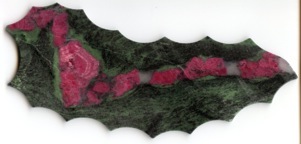Teaching

Each year I teach the sophomore level required major’s course, Mineralogy, which also had an accompanying laboratory encompassing the active learning aspect of the materials. For the past three years, we have embedded specific exercises to help students with spatial and penetrative thinking as part of our NSF-funded study.
Other classes, taught on a rotating basis, include advanced aspects of mineralogy as it relates to petrologically important minerals, as problems and solutions to the environment, as integral to public policy and a course on scientific visualization and communication because novices and experts do not ‘see’ the same material. Advanced courses in mineralogy use course packets developed from Elements articles and RiMG volumes - individually developed and available from MSA.
Publications related to Teaching
Textbook
Klein, C., and Dutrow, B., 2008. The Manual of Mineral Science. 23rd Edition, John Wiley and Sons, Hoboken, NJ. 675 pp. (I reorganized and largely rewrote the first 14 chapter covering conceptual aspects of mineralogy; acquired many new mineral photographs). Released in Feb. 2007.
Klein, C. and Dutrow, B. 2012. Manual de Ciência dos Mienralias. 23rd Edição. Translated into Portuguese. Bookman. 706 pps.
Articles in referred journals
Dutrow, B.L., 2007. Visual communication: Do you see what I see? Elements, v. 3, no. 2, pp. 119-126.
Dutrow, B.L., 2004. Teaching Mineralogy from the core to the crust. J. Geoscience Education, 52:81-86.
Electronic articles
Dutrow, B.L. and Clark, C.M. 2007. X-ray Powder Diffraction. Instructional Module for the Geochemical Instrumentation and Analysis Workshop associated with the Integrating Research and Education-moving research results into geosciences courses program. http://serc.carleton.edu/research education/geochemsheets/techniques/XRD.html
Clark, C.M. and Dutrow, B.L. 2007. Single Crystal X-ray Diffraction. Instructional Module for the Geochemical Instrumentation and Analysis Workshop associated with the Integrating Research and Education-moving research results into geosciences courses program. http://serc.carleton.edu/researcheducation/geochemsheets/techniques/SXD.html
Electonic Publications - Lab exercises
Dutrow, B.L. and Ormand, C. 2015. Spatial Thinking Workbook: Deciphering Mineral Structure Diagrams. http://serc.carleton.edu/spatialworkbook/activities/mineral_diagrams.html
Dutrow, B.L. and Ormand, C. 2015. Spatial Thinking Workbook: Comparing Quartz Polymorphs. http://serc.carleton.edu/spatialworkbook/activities/quartz.html
Dutrow, B.L. and Ormand, C. 2015. Spatial Thinking Workbook: Comparing Phyllosilicate Structures. http://serc.carleton.edu/spatialworkbook/activities/phyllosilicates.html
Dutrow, B.L., Kinari, Atit, and Ormand, C. 2015. Spatial Thinking Workbook: Understanding Crystal Symmetry via Gesture. http://serc.carleton.edu/spatialworkbook/activities/symmetry.html
Dutrow, B.L., Kinari, Atit, and Ormand, C. 2014. Spatial Thinking Workbook: Gestures for Miller Indices. http://serc.carleton.edu/spatialworkbook/activities/Miller_Indices.html
Dutrow, B.L., Kinari, Atit, and Ormand, C. 2014. Spatial Thinking Workbook: Gestures for Silicate Structures. http://serc.carleton.edu/spatialworkbook/activities/silicates.html
Dutrow, B.L. and Ormand, C. 2015. Spatial Thinking Workbook: Understanding Polyhedral Diagrams. http://serc.carleton.edu/spatialworkbook/activities/polyhedra.html
Dutrow, B.L., Kinari, Atit, and Ormand, C. 2014. Spatial Thinking Workbook: Understanding Mineral Cleavage via Gestures. http://serc.carleton.edu/spatialworkbook/activities/mineral_cleavage.html
Dutrow, B.L. 2010. Minerals as recorders of complex systems with coupled processes. http://serc.carleton.edu/NAGTWorkshops/complexsystems/workshop2010/participants/dutrow.html
Dutrow, B.L., 2010. Deciphering complex fluid-mineral interactions in the palm of your hand. (Instructional Module). http://serc.carleton.edu/NAGTWorkshops/complexsystems/activities/fluidmininteract.html
Dutrow, B.L., 2010. Developing visual interpretation of complex geosystems. Invited Panelist for Teaching Complex Systems with Visualizations. http://serc.carleton.edu/NAGTWorkshops/complexsystems/activities/fluidmininteract.html .pdf of presentation available.
Dutrow, B.L. and Mogk, D., 2010. Modeling exsolution (and perthite formation) as an example of complex-system behavior. http://serc.carleton.edu/NAGTWorkshops/complexsystems/activities/exsolution.html
Dutrow, B.L., 1996. Better living through minerals: X-ray diffraction of household products. http://serc.carleton.edu/NAGTWorkshops/mineralogy/activities/householdxrd.html
(click to see syllabus)
Earth Materials and the Environment
Scientific Visualization and Communication
Advanced Metamorphic Petrology
Geochemistry: Fluids in the Crust


Optical scan of boudinaged corundum and plagioclase in vein. Matrix is diopside and paragsite (not zoisite). sample from Tanzania. FoV = 20 cm. Dutrow sample and scan (c).